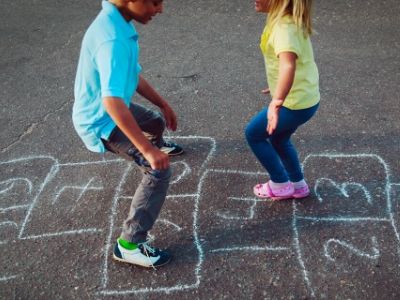Running through a field on a warm, sunny day. Inventing a playground obstacle course with friends. Jumping in puddles on a rainy day. All childhood classics, yet studies from various countries show a trend: Children are spending increasingly less time playing outside. There’s no clear answer for why, although technology use, busy schedules, and less green space have been tossed around as likely culprits.
Whatever the reason for a decline in outdoor play, we’re here as occupational and speech therapists to encourage more of it! Playing outside is developmentally-supportive in so many ways, including these:
It offers varied sensory experiences. Warm sun. A chilly breeze. The cool metal of a playground structure, or the rough feel of playground mulch under bare feet. The smell of rain-soaked dirt and the sound of birds chirping in the trees. When children are outdoors, there is something for every one of their senses to take in.
It supports proprioception (or body awareness). Outdoor play encourages movement, and movement helps children learn how to use their bodies in a coordinated way. This is especially true when playground equipment is involved, because children are continuously challenged to use their bodies in different ways.
It is linked to better vision. Several studies have linked outdoor play with a reduced risk of myopia (or nearsightedness). One particular study involving 6 year-olds showed that an extra 40 minutes of outdoor time a day delayed myopia, or prevented it altogether.
It can improve attention. Research suggests that playing in nature improves attention skills. What’s more, outdoor play has been shown to significantly reduce the symptoms of Attention Deficit Hyperactivity Disorder (ADHD).
It nurtures executive function skills. Executive function skills help us plan, organize, accomplish goals, problem-solve, and much more. Giving children unstructured outdoor play is a unique opportunity for them to rely on and strengthen these skills – especially when they are with peers, using what they find in nature to invent their own activities.
It reinforces language learning. Learning new vocabulary and concepts is enhanced when children experience them in real time. Whether it’s new words: the “crunch” of snow under boots, or new concepts: crawl “through” the tunnel and then climb to the “highest” platform – embodying them is one the best ways to learn.
It builds social skills. This is especially true for unstructured outdoor play, when children need to communicate, generate ideas, negotiate, collaborate, and “play fair” in order to fill and enjoy the time.
Aside from these sensory and language benefits, outdoor play can also:
Encourage exercise. Studies of pre-school aged children have found that outdoor play is linked to lower BMI. Older children may need a little push to engage in active play outside, but that push is a good idea: Children who master movement skills like running, throwing and catching are more active throughout adolescence and adulthood than those who don’t get as much practice with these skills.
Increase vitamin D levels. Too much sun can be a problem, but doctors at Harvard Medical School remind us that a little bit of sun during outdoor play is crucial for bone development, immunity, sleep, mood and more.
Nurture a love for nature. Studies show that children who spend time outside and feel connected to nature grow up to be more environmentally responsible than those who don’t.
Have we convinced you to find more time for your child to play outside? We hope so! Such a simple thing with so many benefits.


Recent Comments